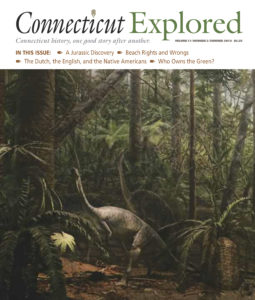(c) Connecticut Explored Inc. Summer 2019
Subscribe/Buy the Issue!
When we decided to go with one-word themes for our issues this year (Winter 2018-2019: Create, Spring 2019: Water, Summer 2019: Land, Fall 2019: Family), we didn’t fully anticipate the range of stories that approach would yield. We often don’t get a complete sense of how an issue will shape up until all of the stories and images are in. Usually we’re surprised and delighted by how an issue comes together.
This issue about land offered a hefty dose of surprise, too—but for me, it was tinged with dismay rather than delight. Chalk it up to my naivete. We’d added a sub-theme to this issue: Contested. I did not anticipate that when you add “contested” to “land,” you get a hot potato of power and politics. In four of our stories, “The Wade In of 1964,” “How Segregation Happened in West Hartford,” “No Day at the Beach,” and “The Federal Government and Redlining in Connecticut,” race and racism turn up the heat on that history. It is not easy reading. But it does the work that history should do—helps us reflect, acknowledge, and strive for better outcomes.
I wish we had the story of Village Creek, a neighborhood in Norwalk celebrating its 70th anniversary this year, in this issue. Luckily, we have a Grating the Nutmeg podcast episode that I highly recommend our readers listen to. In episode 65, “Norwalk’s Village Creek Ahead of Its Time,” Connecticut Historical Society adult programs manager Natalie Belanger and CHS exhibit developer Melica Bloom discuss the post-World War II development of Village Creek and its promise not to discriminate based on “race, color, creed, or politics,” as the development’s prospectus stated. As the Connecticut Freedom Trail website notes, “This principled stance made them heroes to some and enemies to others, but it also made them pioneers in the movement for equal rights.”
Securing one of the last available waterfront parcels in 1949—albeit behind some factories— Roger Willcox and his partners divided Village Creek’s 37 acres into 69 home lots and eight acres of community-owned amenities, including tennis courts, a playground, private beach, and marina. They laid out the lots along three gently curving streets ending in cul-de-sacs. It sounds swanky, but it was designed to be affordable and welcoming to all. This was Willcox’s first development of this kind, and he went on to become a leading advocate for cooperative housing, according to ctfreedomtrail.org. By all accounts, Village Creek has lived up to its principles. Village Creek was listed on the National Register of Historic Places in 2010 and is a site on the Connecticut Freedom Trail.
The archives for the Village Creek Home Owners Association have been deposited at CHS, and the neighborhood’s story was included in CHS’s recent exhibition Pools, Patios, and the Invention of the American Backyard. (See our related story, page 14.) It’s great that Village Creek’s history will be kept in an accessible archive. This is a history worth studying as our country continues to strive to include everyone in the American Dream.
As always, we encourage our readers to get out and about this summer to visit our beautiful Connecticut landscape and the historic sites and museums you’ll find along the way. Turn to Spotlight on page 52 to plan your itinerary. There you’ll find exhibitions and programs happening this summer that you won’t want to miss!
Elizabeth Normen
Publisher
publisher [at]ctexplored.org

